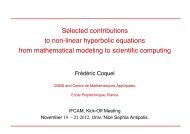John Napier and the invention of logarithms, 1614; a lecture
John Napier and the invention of logarithms, 1614; a lecture
John Napier and the invention of logarithms, 1614; a lecture
Create successful ePaper yourself
Turn your PDF publications into a flip-book with our unique Google optimized e-Paper software.
life tt
<strong>John</strong> <strong>Napier</strong><br />
<strong>and</strong> <strong>the</strong> Invention<br />
<strong>of</strong> Logarithms, <strong>1614</strong>
CAMBRIDGE UNIVERSITY PRESS<br />
C. F. CLAY, Manager<br />
ILotrtJOtt: FETTER LANE, E.C.<br />
ii&mburgf): ioo PRINCES STREET<br />
Berlin: A. ASHER AND CO.<br />
leip>ifl: F. A. BROCKHAUS<br />
$tio Sot*: G. P. PUTNAM'S SONS<br />
Bombag ano Calcutta: MACMILLAN AND CO., Ltd.<br />
ST<strong>of</strong>cso :<br />
Toronto: J. M. DENT AND SONS, Ltd.<br />
THE MARUZEN-KABUSHIKI-KAISHA<br />
All rights reserved
~~h2j°^- m-OWw- £^-y *&'
<strong>John</strong> <strong>Napier</strong> <strong>and</strong> <strong>the</strong> Invention<br />
<strong>of</strong> Logarithms, <strong>1614</strong><br />
A LECTURE<br />
BY<br />
E. W. HOBSON, Sc.D., LL.D., F.R.S.<br />
sadle irian pr<strong>of</strong>essor <strong>of</strong> pure ma<strong>the</strong>matics<br />
fellow <strong>of</strong> Christ's college, Cambridge<br />
Cambridge :<br />
at <strong>the</strong> University Press<br />
1914
(Eambrtoge:<br />
PRINTED BY JOHN CLAY, M.A.<br />
AT THE UNIVERSITY PRESS
JOHN NAPIER AND THE INVENTION<br />
OF LOGARITHMS, <strong>1614</strong><br />
In <strong>the</strong> present year <strong>the</strong>re will be held a<br />
celebration, under <strong>the</strong> auspices <strong>of</strong> <strong>the</strong> Royal<br />
Society <strong>of</strong> Edinburgh, <strong>of</strong> <strong>the</strong> tercentenary <strong>of</strong><br />
one <strong>of</strong> <strong>the</strong> great events in <strong>the</strong> history <strong>of</strong> Science,<br />
<strong>the</strong> publication <strong>of</strong> <strong>John</strong> <strong>Napier</strong>'s<br />
" Mirifici<br />
Logarithmorum Canonis Descriptio," a work<br />
which embodies one <strong>of</strong> <strong>the</strong> very greatest scien-<br />
tific discoveries that <strong>the</strong> world has seen. The<br />
<strong>invention</strong> <strong>of</strong> Logarithms not only marks an<br />
advance <strong>of</strong> <strong>the</strong> first importance in Ma<strong>the</strong>matical<br />
Science, but as providing a great labour-saving<br />
instrument for <strong>the</strong> use <strong>of</strong> all those who have<br />
occasion to carry out extensive numerical calcu-<br />
lations it can be compared in importance only<br />
with <strong>the</strong> great Indian <strong>invention</strong> <strong>of</strong> our system<br />
<strong>of</strong> numeration.<br />
EMS<br />
LIB<br />
Q\<br />
4
6 JOHN NAPIER<br />
It is almost always extremely instructive to<br />
study in detail <strong>the</strong> form in which a great dis-<br />
covery or <strong>invention</strong> was presented by its<br />
originator,<br />
<strong>and</strong> to trace in detail <strong>the</strong> mode in<br />
which <strong>the</strong> fundamental ideas connected with <strong>the</strong><br />
discovery shaped <strong>the</strong>mselves in his mind, even<br />
when, <strong>and</strong> just because, later developments or<br />
simplifications may have so transformed <strong>the</strong> under-<br />
lying principles, <strong>and</strong> still more <strong>the</strong> practice,<br />
<strong>of</strong> <strong>the</strong><br />
<strong>invention</strong>, that we have become accustomed to<br />
look at <strong>the</strong> matter from a point <strong>of</strong> view, at least<br />
superficially, very different from <strong>the</strong> original one<br />
<strong>of</strong> <strong>the</strong> discoverer. The case <strong>of</strong> <strong>logarithms</strong> is very<br />
far from being an exception to this rule ; accord-<br />
ingly I propose to give an account, as concise as<br />
may be, <strong>of</strong> <strong>the</strong> conception <strong>of</strong> a logarithm in <strong>the</strong><br />
mind <strong>of</strong> <strong>Napier</strong>, <strong>and</strong> <strong>of</strong> <strong>the</strong> methods by which he<br />
actually constructed his table <strong>of</strong> <strong>logarithms</strong>.<br />
In order fully to appreciate <strong>the</strong> nature <strong>of</strong> <strong>the</strong><br />
difficulties <strong>of</strong> <strong>the</strong> task accomplished by <strong>the</strong> genius<br />
<strong>of</strong> <strong>John</strong> <strong>Napier</strong>, some effort <strong>of</strong> imagination is
JOHN NAPIER 7<br />
required, to be expended in realizing<br />
<strong>the</strong> narrow-<br />
ness <strong>of</strong> <strong>the</strong> means available in <strong>the</strong> early part <strong>of</strong><br />
<strong>the</strong> seventeenth century for <strong>the</strong> calculation <strong>of</strong> <strong>the</strong><br />
tables, at a time, before <strong>the</strong> <strong>invention</strong> <strong>of</strong> <strong>the</strong><br />
Differential <strong>and</strong> Integral Calculus, when calcula-<br />
tion by means <strong>of</strong> infinite series had not yet been<br />
invented. <strong>Napier</strong>'s conception <strong>of</strong> a logarithm<br />
involved a perfectly clear apprehension <strong>of</strong> <strong>the</strong><br />
nature <strong>and</strong> consequences <strong>of</strong> a certain functional<br />
relationship, at a time when no general conception<br />
<strong>of</strong> such a relationship had been formulated, or<br />
existed in <strong>the</strong> minds <strong>of</strong> Ma<strong>the</strong>maticians, <strong>and</strong><br />
before <strong>the</strong> intuitional aspect <strong>of</strong> that relationship<br />
had been clarified by means <strong>of</strong> <strong>the</strong> great <strong>invention</strong><br />
<strong>of</strong> coordinate geometry made later in <strong>the</strong> century<br />
by<br />
Ren£ Descartes. A modern Ma<strong>the</strong>matician<br />
regards <strong>the</strong> logarithmic<br />
an exponential function ; <strong>and</strong><br />
function as <strong>the</strong> inverse <strong>of</strong><br />
it may seem to us,<br />
familiar as we all are with <strong>the</strong> use <strong>of</strong> operations<br />
involving indices, that <strong>the</strong> conception <strong>of</strong> a loga-<br />
rithm would present itself in that connection as a
8 JOHN NAPIER<br />
fairly<br />
obvious one. We must however remember<br />
that, at <strong>the</strong> time <strong>of</strong> <strong>Napier</strong>, <strong>the</strong> notion <strong>of</strong> an index,<br />
in its generality, was no part <strong>of</strong> <strong>the</strong> stock <strong>of</strong> ideas<br />
<strong>of</strong> a Ma<strong>the</strong>matician, <strong>and</strong> that <strong>the</strong> exponential<br />
notation was not yet in use.<br />
Summary <strong>of</strong> <strong>the</strong> life <strong>of</strong> <strong>Napier</strong>.<br />
I must content myself with giving an exceed-<br />
ingly brief account <strong>of</strong> <strong>the</strong> external facts <strong>of</strong> <strong>the</strong> life<br />
<strong>of</strong> <strong>Napier</strong>*.<br />
<strong>John</strong> <strong>Napier</strong>^, <strong>the</strong> eighth <strong>Napier</strong> <strong>of</strong> Merchiston,<br />
usually described as Baron, or Fear, <strong>of</strong> Merchiston,<br />
was born at Merchiston near Edinburgh in 1550,<br />
when his fa<strong>the</strong>r Archibald <strong>Napier</strong> was little more<br />
than sixteen years old. <strong>John</strong> <strong>Napier</strong> matriculated<br />
at St Andrews in 1563, but did not stay <strong>the</strong>re<br />
* For a full account <strong>of</strong> <strong>the</strong> life <strong>and</strong> activities <strong>of</strong> <strong>Napier</strong> <strong>the</strong><br />
" "<br />
Memoirs <strong>of</strong> <strong>John</strong> <strong>Napier</strong> <strong>of</strong> Merchiston by Mark <strong>Napier</strong>,<br />
published in 1834, may be consulted.<br />
t The name <strong>Napier</strong> was spelled in various ways, several<br />
<strong>of</strong> which were used by <strong>John</strong> <strong>Napier</strong>; thus we find Napeir,<br />
Nepair, Nepeir, Neper, Nepper, Naper, Napare, Naipper.
JOHN NAPIER 9<br />
sufficiently long to graduate, as he departed<br />
previous to 1566 in order to pursue<br />
his studies<br />
on <strong>the</strong> Continent, whence he returned to Mer-<br />
chiston in or before 1571. His first marriage, by<br />
which he had one son Archibald who was raised<br />
to <strong>the</strong> peerage in 1627 as Lord <strong>Napier</strong>, <strong>and</strong> one<br />
daughter, took place in 1572. A few years after<br />
<strong>the</strong> death <strong>of</strong> his wife in 1579, he married again.<br />
By his second marriage<br />
he had five sons <strong>and</strong><br />
five daughters ; <strong>the</strong> second son, Robert, was his<br />
literary executor. The invasion <strong>of</strong> <strong>the</strong> Spanish<br />
Armada in 1588 led <strong>Napier</strong>, as an ardent Protes-<br />
tant, to take a considerable part in Church politics.<br />
In January 159^ he published his first work "A<br />
plaine discovery<br />
<strong>of</strong> <strong>the</strong> whole Revelation <strong>of</strong><br />
St <strong>John</strong>." This book is regarded as <strong>of</strong> consider-<br />
able importance in <strong>the</strong> history <strong>of</strong> Scottish <strong>the</strong>o-<br />
logical literature, as it contained a method <strong>of</strong><br />
interpretation much in advance <strong>of</strong> <strong>the</strong> age ;<br />
it<br />
passed through several editions in English, French,<br />
German, <strong>and</strong> Dutch.
io JOHN NAPIER<br />
In July 1594, <strong>Napier</strong> entered into a curious<br />
contract with a turbulent baron, Robert Logan <strong>of</strong><br />
Restalrig, who had just<br />
been outlawed. In this<br />
contract, which appears to shew that <strong>John</strong> <strong>Napier</strong><br />
was not free from <strong>the</strong> prevalent belief in Magic,<br />
he agreed to endeavour to discover a treasure<br />
supposed to lie hidden in Logan's dwelling-place,<br />
Fast Castle. <strong>Napier</strong> was to receive a third part<br />
<strong>of</strong> <strong>the</strong> treasure when found, in consideration that<br />
"<strong>the</strong> said J hone sail do his utter & exact dili-<br />
gens to serche & sik out, <strong>and</strong> be al craft & ingyne<br />
that he dow, to tempt, trye, <strong>and</strong> find out <strong>the</strong><br />
sam, <strong>and</strong> be <strong>the</strong> grace <strong>of</strong> God, a<strong>the</strong>r sail find <strong>the</strong><br />
sam, or than mak it suir that na sik thing hes<br />
been thair ;<br />
ingyne may reach."<br />
gave<br />
sa far as his utter trawell diligens <strong>and</strong><br />
In a document dated June 7, 1596, <strong>Napier</strong><br />
an account <strong>of</strong> some secret <strong>invention</strong>s he had<br />
made which were "pr<strong>of</strong>fitabill & necessary in<br />
<strong>the</strong>is dayes for <strong>the</strong> defence <strong>of</strong> this H<strong>and</strong> & withst<strong>and</strong>ing<br />
<strong>of</strong> strangers enemies <strong>of</strong> God's truth &
elegion."<br />
JOHN NAPIER ii<br />
His activities in this direction were no<br />
doubt stimulated by <strong>the</strong> fear <strong>of</strong> <strong>the</strong> generally<br />
expected invasion by Philip <strong>of</strong> Spain. It is<br />
interesting to note <strong>the</strong>m, in view <strong>of</strong> <strong>the</strong> military<br />
tastes <strong>of</strong> many <strong>of</strong> his descendants. The <strong>invention</strong>s<br />
consisted <strong>of</strong> a mirror for burning <strong>the</strong> enemies'<br />
ships at any distance, <strong>of</strong> a piece <strong>of</strong> artillery capable<br />
<strong>of</strong> destroying everything round an arc <strong>of</strong> a circle,<br />
<strong>and</strong> <strong>of</strong> a round metal chariot so constructed that<br />
its occupants could move it rapidly <strong>and</strong> easily,<br />
while firing out through small holes in it. <strong>Napier</strong>'s<br />
practical<br />
bent <strong>of</strong> mind was also exhibited in <strong>the</strong><br />
attention he paid to agriculture, especially on <strong>the</strong><br />
Merchiston estate, where <strong>the</strong> l<strong>and</strong> was tilled by a<br />
system <strong>of</strong> manuring with salt.<br />
There is evidence that Ma<strong>the</strong>matics occupied<br />
<strong>Napier</strong>'s attention from an early age. From a<br />
MS. that was first published in 1839 under <strong>the</strong><br />
title<br />
" De Arte Logistica "<br />
it appears that his<br />
investigations in Arithmetic <strong>and</strong> Algebra<br />
had led<br />
him to a consideration <strong>of</strong> <strong>the</strong> imaginary roots <strong>of</strong>
12 JOHN NAPIER<br />
equations, <strong>and</strong> to a general<br />
method for <strong>the</strong> ex-<br />
traction <strong>of</strong> roots <strong>of</strong> numbers <strong>of</strong> all degrees.<br />
But,<br />
led probably by <strong>the</strong> circumstances <strong>of</strong> <strong>the</strong> time, he<br />
put aside this work in order to devote himself to<br />
<strong>the</strong> discovery <strong>of</strong> means <strong>of</strong> diminishing <strong>the</strong> labour<br />
involved in numerical computations.<br />
The second<br />
half <strong>of</strong> <strong>the</strong> sixteenth century was <strong>the</strong> time in which<br />
<strong>the</strong> Ma<strong>the</strong>maticians <strong>of</strong> <strong>the</strong> Continent devoted a<br />
great deal <strong>of</strong> attention to <strong>the</strong> calculation <strong>of</strong> tables<br />
<strong>of</strong> natural trigonometrical functions. The most<br />
prominent name in this connection is that <strong>of</strong><br />
Georg Joachim Rheticus, <strong>the</strong> great computer<br />
whose work has never been superseded, <strong>and</strong> <strong>the</strong><br />
final result <strong>of</strong> whose labours is embodied in <strong>the</strong><br />
table <strong>of</strong> natural sines for every ten seconds to<br />
fifteen places <strong>of</strong> decimals, published by<br />
Pitiscus in<br />
1613, <strong>the</strong> year before <strong>the</strong> publication by <strong>Napier</strong><br />
<strong>of</strong> <strong>the</strong> discovery which was destined to revolu-<br />
tionize all <strong>the</strong> methods <strong>of</strong> computation, <strong>and</strong> to<br />
substitute <strong>the</strong> use <strong>of</strong> logarithmic for that <strong>of</strong> natural<br />
trigonometrical functions. It was in <strong>the</strong> early
JOHN NAPIER 13<br />
years <strong>of</strong> <strong>the</strong> seventeenth century that Johannes<br />
Kepler was engaged in <strong>the</strong> prodigious<br />
task <strong>of</strong><br />
discovering, <strong>and</strong> verifying by numerical calculation,<br />
<strong>the</strong> laws <strong>of</strong> <strong>the</strong> motion <strong>of</strong> <strong>the</strong> planets.<br />
In this age<br />
<strong>of</strong> numerical calculation <strong>the</strong>n <strong>Napier</strong> occupied<br />
himself with <strong>the</strong> <strong>invention</strong> <strong>of</strong> methods for <strong>the</strong> '<br />
diminution <strong>of</strong> <strong>the</strong> labour <strong>the</strong>rein involved. He<br />
himself states in his<br />
" Rabdologia," to which<br />
reference will presently be made, that <strong>the</strong><br />
canon <strong>of</strong> <strong>logarithms</strong> is "a me longo tempore<br />
elaboratum." It appears from a letter <strong>of</strong> Kepler<br />
that a Scotsman, probably Thomas Craig, a<br />
friend <strong>of</strong> <strong>the</strong> <strong>Napier</strong> family, gave <strong>the</strong> astronomer<br />
Tycho Brahe in <strong>the</strong> year 1594 hopes<br />
that an<br />
important simplification in <strong>the</strong> processes <strong>of</strong> arith-<br />
metic would become available. There is strong<br />
evidence that <strong>Napier</strong> communicated his hopes to<br />
Craig twenty years before <strong>the</strong> publication<br />
Canon.<br />
The " Descriptio,"<br />
<strong>of</strong> <strong>the</strong><br />
<strong>of</strong> which an account will<br />
be given presently, was as stated at <strong>the</strong> outset
i 4 JOHN NAPIER<br />
published in <strong>1614</strong>. About <strong>the</strong> same time <strong>Napier</strong><br />
devised several mechanical aids for <strong>the</strong> perform-<br />
ance <strong>of</strong> multiplications <strong>and</strong> divisions <strong>and</strong> for <strong>the</strong><br />
extraction <strong>of</strong> square <strong>and</strong> cube roots. He published<br />
an account <strong>of</strong> <strong>the</strong>se <strong>invention</strong>s in 161 7 in his<br />
" Rabdologia," as he says, " for <strong>the</strong> sake <strong>of</strong> those<br />
who may prefer to work with <strong>the</strong> natural numbers."<br />
The method which <strong>Napier</strong> calls Rabdologia<br />
consists <strong>of</strong> calculation <strong>of</strong> multiplications <strong>and</strong><br />
divisions by means <strong>of</strong> a set <strong>of</strong> rods, usually called<br />
"<strong>Napier</strong>'s bones." In 1617, immediately after<br />
<strong>the</strong> publication <strong>of</strong> <strong>the</strong> " Rabdologia," <strong>Napier</strong><br />
died.<br />
The " Descriptio " did not contain an account<br />
<strong>of</strong> <strong>the</strong> methods by which <strong>the</strong> " wonderful canon "<br />
was constructed. In an "Admonitio" printed at<br />
<strong>the</strong> end <strong>of</strong> Chapter 11, <strong>Napier</strong> explains<br />
that he<br />
prefers, before publishing <strong>the</strong> method <strong>of</strong> construc-<br />
tion, to await <strong>the</strong> opinion <strong>of</strong> <strong>the</strong> learned world<br />
on <strong>the</strong> canon ; he says " For I expect <strong>the</strong> judge-<br />
ment & censure <strong>of</strong> learned men hereupon, before
JOHN NAPIER 15<br />
<strong>the</strong> rest rashly published, be exposed<br />
detraction <strong>of</strong> <strong>the</strong> envious."<br />
to <strong>the</strong><br />
The " Mirifici Logarithmorum Canonis Con-<br />
struction' which contains a full explanation <strong>of</strong> <strong>the</strong><br />
method <strong>of</strong> construction <strong>of</strong> <strong>the</strong> wonderful canon,<br />
<strong>and</strong> a clear account <strong>of</strong> <strong>Napier</strong>'s <strong>the</strong>ory <strong>of</strong> loga-<br />
rithms, was published by his son Robert <strong>Napier</strong><br />
in 16 1 9. In <strong>the</strong> preface by Robert <strong>Napier</strong> it is<br />
stated that this work was written by his fa<strong>the</strong>r<br />
several years before <strong>the</strong> word "logarithm" was<br />
invented, <strong>and</strong> consequently at an earlier date than<br />
that <strong>of</strong> <strong>the</strong> publication <strong>of</strong> <strong>the</strong> "Descriptio." In<br />
<strong>the</strong> latter <strong>the</strong> word " logarithm " is used through-<br />
out, but in <strong>the</strong> " Constructio," except in <strong>the</strong> title,<br />
<strong>logarithms</strong> are called " numeri artificiales." After<br />
explaining that <strong>the</strong> author had not put<br />
<strong>the</strong> finish-<br />
ing touch to <strong>the</strong> little treatise, <strong>the</strong> Editor writes<br />
"Nor do I doubt that this posthumous work<br />
would have seen <strong>the</strong> light in a much more perfect<br />
& finished state, if God had granted a longer<br />
enjoyment <strong>of</strong> life to <strong>the</strong> Author, my most dearly
1 6 JOHN NAPIER<br />
beloved fa<strong>the</strong>r, in whom, by <strong>the</strong> opinion<br />
<strong>of</strong> <strong>the</strong><br />
wisest men, among o<strong>the</strong>r illustrious gifts this<br />
shewed itself pre-eminent, that <strong>the</strong> most difficult<br />
matters were unravelled by a sure <strong>and</strong> easy<br />
method, as well as in <strong>the</strong> fewest words."<br />
Reception <strong>of</strong> <strong>the</strong> Canon by Contemporary<br />
Ma<strong>the</strong>maticians.<br />
The new <strong>invention</strong> attracted <strong>the</strong> attention<br />
ol British <strong>and</strong> Foreign Ma<strong>the</strong>maticians with a<br />
rapidity which may well surprise<br />
us when we take<br />
into account <strong>the</strong> circumstances <strong>of</strong> <strong>the</strong> time. In<br />
particular <strong>the</strong> publication<br />
<strong>of</strong> <strong>the</strong> wonderful canon<br />
was received by Kepler with marked enthusiasm.<br />
In his "Ephemeris" for 1620, Kepler published<br />
as <strong>the</strong> dedication a letter addressed to <strong>Napier</strong>,<br />
dated July 28, 161 9, congratulating him warmly<br />
on his <strong>invention</strong> <strong>and</strong> on <strong>the</strong> benefit he had con-<br />
ferred upon Astronomy. Kepler explains how he<br />
verified <strong>the</strong> canon <strong>and</strong> found no essential errors
JOHN NAPIER 17<br />
in it, beyond a few inaccuracies near <strong>the</strong> begin-<br />
ning <strong>of</strong> <strong>the</strong> quadrant.<br />
The letter was written two<br />
years after <strong>Napier</strong>'s death, <strong>of</strong> which Kepler had<br />
not heard. In 1624 Kepler himself published a<br />
table <strong>of</strong> <strong>Napier</strong>ian <strong>logarithms</strong> with modifications<br />
<strong>and</strong> additions. The " Descriptio," on its publi-<br />
cation in 1 6 14, at once attracted <strong>the</strong> attention <strong>of</strong><br />
Henry Briggs (1 556-1 630), Fellow <strong>of</strong> St <strong>John</strong>'s<br />
College, Cambridge,<br />
Gresham Pr<strong>of</strong>essor <strong>of</strong> Geo-<br />
metry in <strong>the</strong> City <strong>of</strong> London, <strong>and</strong> afterwards<br />
Savilian Pr<strong>of</strong>essor <strong>of</strong> Geometry at Oxford, to<br />
whose work as <strong>the</strong> successor <strong>of</strong> <strong>Napier</strong> in <strong>the</strong> task<br />
<strong>of</strong> construction <strong>of</strong> logarithmic tables in an improved<br />
form I shall have to refer later. In a letter<br />
to Archbishop Ussher, dated Gresham House,<br />
March 10, 161 5, Briggs wrote, " Napper,<br />
Markinston, hath set my<br />
lord <strong>of</strong><br />
head & h<strong>and</strong>s a work<br />
with his new & admirable <strong>logarithms</strong>. I hope to<br />
see him this summer, if it please God, for I never<br />
saw book which pleased me better, or made me<br />
more wonder." Briggs visited <strong>Napier</strong>, <strong>and</strong> stayed<br />
H.
1 8 JOHN NAPIER<br />
with him a month in 1615, again visited him in<br />
1 61 6, <strong>and</strong> intended to visit him again in 16 17,<br />
had <strong>Napier</strong>'s life been spared. Ano<strong>the</strong>r eminent<br />
English Ma<strong>the</strong>matician, Edward Wright, a Fellow<br />
<strong>of</strong> Gonville <strong>and</strong> Caius College, who at once saw<br />
<strong>the</strong> importance <strong>of</strong> <strong>logarithms</strong> in connection with<br />
navigation, in <strong>the</strong> history <strong>of</strong> which he occupies a<br />
conspicuous place, translated <strong>the</strong> " Descriptio,"<br />
but died in 161 5 before it could be published.<br />
The translation was however published in 1618<br />
by his son Samuel Wright.<br />
The contents <strong>of</strong> <strong>the</strong> " Descriptio " <strong>and</strong> <strong>of</strong> <strong>the</strong><br />
" Construction<br />
The " Descriptio " consists <strong>of</strong> an ornamental<br />
title page, fifty-seven pages <strong>of</strong> explanatory matter,<br />
<strong>and</strong> ninety pages <strong>of</strong> tables. A specimen page <strong>of</strong><br />
<strong>the</strong> tables is here reproduced. The explanatory<br />
matter contains an account <strong>of</strong> <strong>Napier</strong>'s conception<br />
<strong>of</strong> a logarithm, <strong>and</strong> <strong>of</strong> <strong>the</strong> principal properties <strong>of</strong><br />
<strong>logarithms</strong>, <strong>and</strong> also <strong>of</strong> <strong>the</strong>ir application<br />
in <strong>the</strong>
Gr.<br />
P<br />
fnin\<br />
+ 1<br />
Smut } Logarithmi \ Differentia \ U^arithmi<br />
f<br />
| Sinus f<br />
1*6434?<br />
1*67218<br />
1570091<br />
1572964<br />
15787°?<br />
1581*81<br />
1*84453<br />
15873**<br />
1590197<br />
1593069<br />
I59594I<br />
1598812<br />
1601684<br />
1604555<br />
1607426<br />
1610297<br />
1613168<br />
1616038<br />
1618909<br />
1621779<br />
1624649<br />
1627*19<br />
1630389<br />
76 33~259<br />
1636129<br />
1638999<br />
1641868<br />
1644738<br />
1647607<br />
16*0476<br />
I K<br />
18**1174<br />
18532826<br />
18514*11'<br />
1849*23*<br />
18477984<br />
1 8459772<br />
18441594<br />
18423451<br />
18405341<br />
18387265<br />
18369223<br />
18351214<br />
18333237<br />
18315294<br />
182^7384<br />
18279*07<br />
18261663<br />
182438*1<br />
18226071<br />
18208323<br />
18190606<br />
18172924<br />
1815*273<br />
18137654<br />
18120067<br />
18102*11<br />
18084987<br />
1806749*<br />
18050034<br />
18032604<br />
1801*207<br />
\<br />
—<br />
18427295<br />
18408484<br />
18389707<br />
j 8 370964<br />
183*2253<br />
i83>35 76<br />
183H933<br />
18296324<br />
18277747<br />
18259203<br />
18240692<br />
18222213<br />
18203765<br />
1818*3*1<br />
18166969<br />
18148619<br />
18130301<br />
18112014<br />
18093758<br />
1807*533<br />
180573 z 8<br />
18039177<br />
18021047<br />
18002948<br />
17984880<br />
17966842<br />
17948835<br />
17930859<br />
17912913<br />
17894997<br />
T7I77TT4<br />
113*81<br />
124342<br />
124804<br />
125267<br />
12*731<br />
1 26 196<br />
126662<br />
127127<br />
i"-7*94<br />
128062<br />
128*31<br />
129061<br />
? 29472<br />
129943<br />
130415<br />
130888]<br />
1 3 1 3 62<br />
131837<br />
13*313<br />
132790<br />
133268<br />
133747<br />
13-4226<br />
134706<br />
13*187<br />
13*669<br />
136152<br />
136636<br />
137121<br />
137607<br />
138093<br />
80<br />
9876882<br />
5876427<br />
9875971<br />
9875514<br />
987*056<br />
9874597<br />
0874137<br />
9873677<br />
9873216<br />
9872754<br />
9872291<br />
9871362<br />
9870897<br />
98704^1<br />
9869964<br />
9869496<br />
9869027 1<br />
60<br />
59<br />
_**<br />
57<br />
56<br />
jj<br />
*4<br />
*3<br />
*2<br />
51<br />
50<br />
9871827 J 49<br />
9X6^5 57.1<br />
9868087<br />
9867616 I<br />
9867144<br />
9866671<br />
9866197<br />
9*65722<br />
9865246<br />
9864770<br />
9864293<br />
9863815<br />
9863336<br />
98628*6<br />
48<br />
47<br />
46<br />
4*<br />
44<br />
43<br />
4*<br />
41<br />
43<br />
39<br />
38<br />
37<br />
36<br />
3*<br />
34<br />
33<br />
3*<br />
u 30<br />
ttin<br />
t
JOHN NAPIER 19<br />
solution <strong>of</strong> plane <strong>and</strong> spherical triangles. <strong>Napier</strong>'s<br />
well-known rules <strong>of</strong> circular parts containing <strong>the</strong><br />
complete system<br />
<strong>of</strong> formulae for <strong>the</strong> solution <strong>of</strong><br />
right-angled spherical triangles are here given.<br />
The <strong>logarithms</strong> given in <strong>the</strong> tables are those <strong>of</strong><br />
<strong>the</strong> sines <strong>of</strong> angles from o° to 90<br />
one minute, to seven or eight figures.<br />
at intervals <strong>of</strong><br />
The table<br />
is arranged semi-quadrantally, so that <strong>the</strong> loga-<br />
rithms <strong>of</strong> <strong>the</strong> sine <strong>and</strong> <strong>the</strong> cosine <strong>of</strong> an angle<br />
appear on <strong>the</strong> same line, <strong>the</strong>ir difference being<br />
given<br />
in <strong>the</strong> table <strong>of</strong> differentiae which thus forms<br />
a table <strong>of</strong> logarithmic tangents. It must be<br />
remembered that, at that time <strong>and</strong> long after-<br />
wards, <strong>the</strong> sine <strong>of</strong> an angle was not regarded, as<br />
at present, as a ratio, but as <strong>the</strong> length <strong>of</strong> that<br />
semi-chord <strong>of</strong> a circle <strong>of</strong> given radius which sub-<br />
tends <strong>the</strong> angle at <strong>the</strong> centre. <strong>Napier</strong><br />
radius to consist <strong>of</strong> io 7<br />
90°, called <strong>the</strong> whole sine, is io v<br />
took <strong>the</strong><br />
units, <strong>and</strong> thus <strong>the</strong> sine <strong>of</strong><br />
; <strong>the</strong> sines <strong>of</strong><br />
smaller angles decreasing from this value to zero.<br />
The table is <strong>the</strong>refore one <strong>of</strong> <strong>the</strong> <strong>logarithms</strong> <strong>of</strong><br />
2— 2
2o JOHN NAPIER<br />
numbers between io 7<br />
<strong>and</strong> o, not for equidistant<br />
numbers, but for <strong>the</strong> numbers corresponding to<br />
equidistant angles. It is important to observe<br />
that <strong>the</strong> <strong>logarithms</strong> in <strong>Napier</strong>'s tables are not<br />
what we now know under <strong>the</strong> name <strong>of</strong> <strong>Napier</strong>ian<br />
or natural <strong>logarithms</strong>, i.e. <strong>logarithms</strong> to <strong>the</strong><br />
base e. His <strong>logarithms</strong> are more closely related<br />
to those to <strong>the</strong> base i/e ; <strong>the</strong> exact relation<br />
Nap<br />
is that, if x is a number, <strong>and</strong> Log x its<br />
logarithm in accordance with <strong>Napier</strong>'s tables,<br />
Nap<br />
T qqt % . — X —-<br />
^— is <strong>the</strong> logarithm <strong>of</strong> t to <strong>the</strong> base<br />
7 b<br />
io 7<br />
io<br />
lie ;<br />
thus<br />
Nap<br />
, > Log.*<br />
X /l V<br />
io'<br />
io' \ej<br />
Nap<br />
or Log x = i o 7<br />
loge i o7 — i o 7<br />
loge x.<br />
<strong>Napier</strong> had no explicit knowledge <strong>of</strong> <strong>the</strong> exist-<br />
ence <strong>of</strong> <strong>the</strong> number £, nor <strong>of</strong> <strong>the</strong> notion <strong>of</strong> <strong>the</strong><br />
base <strong>of</strong> a system <strong>of</strong> <strong>logarithms</strong>, although as we<br />
shall see he was fully cognizant <strong>of</strong> <strong>the</strong> arbitrary
JOHN NAPIER 21<br />
element in <strong>the</strong> possible systems <strong>of</strong> <strong>logarithms</strong>.<br />
His choice was made with a view to making <strong>the</strong><br />
<strong>logarithms</strong> <strong>of</strong> <strong>the</strong> sines <strong>of</strong> angles<br />
between o° <strong>and</strong><br />
90 i.e. <strong>of</strong> , numbers between o <strong>and</strong> io 7<br />
, positive<br />
<strong>and</strong> so as to contain a considerable integral part<br />
The " Constructio " consists <strong>of</strong> a preface <strong>of</strong><br />
two pages, <strong>and</strong> fifty-seven pages <strong>of</strong> text. The<br />
conception <strong>of</strong> a logarithm is here clearly explained,<br />
<strong>and</strong> a full account is given <strong>of</strong> <strong>the</strong> successive steps<br />
by which <strong>the</strong> Canon was actually<br />
constructed. In<br />
this work one <strong>of</strong> <strong>the</strong> four formulae for <strong>the</strong> solution<br />
<strong>of</strong> spherical triangles, known as <strong>Napier</strong>'s analogies,<br />
is given, expressed in words ; <strong>the</strong> o<strong>the</strong>r three<br />
formulae were afterwards added by Briggs, being<br />
easily deducible from <strong>Napier</strong>'s results.<br />
The decimal point.<br />
Our present notation for numbers with <strong>the</strong><br />
decimal point appears to have been independently<br />
invented by <strong>Napier</strong>, although a point or a half<br />
bracket is said to have been employed somewhat
22 JOHN NAPIER<br />
earlier by Jobst Biirgi for <strong>the</strong> purpose <strong>of</strong> separat-<br />
ing <strong>the</strong> decimal places from <strong>the</strong> integral part<br />
<strong>of</strong> a<br />
number*. The <strong>invention</strong> <strong>of</strong> decimal fractions was<br />
due to Simon Stevin (i 548-1 620), who published<br />
a tract in Dutch, "De Thiende," in 1585, <strong>and</strong> in<br />
<strong>the</strong> same year one in French under <strong>the</strong> title " La<br />
Disme," in which <strong>the</strong> system <strong>of</strong> decimal fractions<br />
was introduced, <strong>and</strong> in which a decimal system <strong>of</strong><br />
weights, measures <strong>and</strong> coinage was recommended.<br />
In <strong>the</strong> "Rabdologia" <strong>Napier</strong> refers to Stevin in an<br />
'* Admonitio pro Decimali Arithmetica " in which<br />
he emphasizes <strong>the</strong> simplification arising from <strong>the</strong><br />
use <strong>of</strong> decimals, <strong>and</strong> introduces <strong>the</strong> notation with<br />
<strong>the</strong> decimal point. By Stevin <strong>and</strong> o<strong>the</strong>rs <strong>the</strong><br />
notation 94© 1 ©3 ®o® 5 or 94 i'fo'"f",<br />
for example, was used instead <strong>of</strong> <strong>Napier</strong>'s notation<br />
94*1305. Later on Briggs sometimes used <strong>the</strong><br />
notation 941305. It is clear that <strong>the</strong> notation<br />
introduced by <strong>Napier</strong>, which was however not<br />
* The decimal point was also employed by Pitiscus in <strong>the</strong><br />
tables appended to <strong>the</strong> later edition, published in 1612, <strong>of</strong> his<br />
" Trigonometria."
JOHN NAPIER 23<br />
universally adopted until <strong>the</strong> eighteenth century,<br />
was far better adapted than <strong>the</strong> more complicated<br />
notation used by Stevin <strong>and</strong> later writers to bring<br />
out <strong>the</strong> complete parity <strong>of</strong> <strong>the</strong> integral <strong>and</strong> decimal<br />
parts <strong>of</strong> a number in relation to <strong>the</strong> operations <strong>of</strong><br />
arithmetic, <strong>and</strong> to emphasize <strong>the</strong> fact that <strong>the</strong><br />
system <strong>of</strong> decimal fractions involves only an<br />
extension <strong>of</strong> <strong>the</strong> fundamental conception <strong>of</strong> our<br />
system <strong>of</strong> notation for integral numbers, that <strong>the</strong><br />
value <strong>of</strong> a digit, in relation to <strong>the</strong> decimal scale, is<br />
completely indicated by its position.<br />
<strong>Napier</strong> s definition <strong>of</strong> a logarithm.<br />
1 1<br />
A T
24 JOHN NAPIER<br />
S. He supposes that on ano<strong>the</strong>r straight line a<br />
point Q moves with uniform velocity equal to that<br />
which P has when at T, <strong>and</strong> that Q is at T lt when<br />
P is at T. When P has any particular position<br />
Pj in <strong>the</strong> course <strong>of</strong> its motion, <strong>the</strong> logarithm <strong>of</strong> <strong>the</strong><br />
sine or length SP1<br />
is defined to be <strong>the</strong> number<br />
representing <strong>the</strong> length TX QX , from Tx<br />
to <strong>the</strong><br />
position
JOHN NAPIER 25<br />
described by P in equal times. <strong>Napier</strong> <strong>the</strong>n<br />
shews by means <strong>of</strong> special illustrations that<br />
<strong>and</strong> thus that, corresponding to a series <strong>of</strong> values,<br />
<strong>of</strong> T^Q that are in arithmetic progression, <strong>the</strong>re<br />
are a series <strong>of</strong> values <strong>of</strong> SP that are in geometric<br />
progression.<br />
The matter may be put in a concise form<br />
which represents <strong>the</strong> gist <strong>of</strong> <strong>Napier</strong>'s reasoning,<br />
<strong>and</strong> <strong>of</strong> <strong>the</strong> essential point <strong>of</strong> which he had a clear<br />
intuition.<br />
1<br />
P P'<br />
PS PS<br />
Let -p-* = -^-p. ; <strong>and</strong><br />
><br />
r-J 1<br />
.<br />
let p be any point<br />
in PxP it <strong>and</strong> /' <strong>the</strong> corresponding point in P t P, ;<br />
so that P,p :<br />
pP^P^p'<br />
:<br />
<strong>the</strong> moving point when at/<br />
p'P3<br />
. The<br />
velocity <strong>of</strong><br />
bears a constant ratio<br />
^=^=-~-p) to its velocity when at /.<br />
As this holds for every corresponding pair <strong>of</strong>
26 JOHN NAPIER<br />
points p,p' in <strong>the</strong> two intervals PXP» P 2P 3 ,<br />
it is<br />
dear that <strong>the</strong> motion in P^P% takes place in <strong>the</strong><br />
same time as that in PJ\ ;<br />
corresponding points being changed<br />
<strong>the</strong> velocities at all<br />
in <strong>the</strong> same<br />
ratio, that <strong>of</strong> P xP t to P2P a . Hence <strong>the</strong> result<br />
follows that<br />
P 1S_P2S_P9S_<br />
P tS m P tS m P tS m " u<br />
if <strong>the</strong> points Qlf \ i.e. if <strong>the</strong> spaces P xP %t<br />
P2P P 3 , 3P 4 , ... are described in equal<br />
times. Thus<br />
<strong>the</strong> <strong>logarithms</strong> <strong>of</strong> a set <strong>of</strong> numbers in geometric<br />
progression are <strong>the</strong>mselves in arithmetic pro-<br />
gression.<br />
In our modern notation, if x = SP, we have<br />
— = r, where V denotes <strong>the</strong> velocity <strong>of</strong> P<br />
dt io 7<br />
at T; <strong>and</strong> if V—'T.Q, -Z=V\ thus =<br />
* -y- =;<br />
dt dy io 7<br />
<strong>and</strong> accordingly <strong>Napier</strong>'s method amounts to an<br />
intuitional representation <strong>of</strong> <strong>the</strong> integration <strong>of</strong> this<br />
differential equation.
JOHN NAPIER 27<br />
The limits <strong>of</strong> a logarithm.<br />
As no method was available by which a<br />
logarithm could be calculated to an arbitrarily<br />
great degree <strong>of</strong> approximation, <strong>Napier</strong> obtained<br />
two limits between which a logarithm must lie,<br />
<strong>and</strong> his whole method <strong>of</strong> construction depends<br />
upon <strong>the</strong> use <strong>of</strong> <strong>the</strong>se limits, toge<strong>the</strong>r with corre-<br />
sponding<br />
limits for <strong>the</strong> value <strong>of</strong> <strong>the</strong> difference <strong>of</strong><br />
<strong>the</strong> <strong>logarithms</strong> <strong>of</strong> two numbers.<br />
— 1 1 1<br />
T P x S<br />
—1 1 1<br />
ft T, G<br />
Since <strong>the</strong> velocities <strong>of</strong> P <strong>and</strong> Q at T, Tx are<br />
<strong>the</strong> same, <strong>and</strong> <strong>the</strong> velocity <strong>of</strong> P decreases after-<br />
wards whereas that <strong>of</strong> Q remains constant, it is<br />
clear that TPl < T^Q^. Again let T on <strong>the</strong> left<br />
pt<br />
<strong>of</strong> T be described in <strong>the</strong> same time as TP Xi so<br />
that = ^7", 7\Qv It is <strong>the</strong>n clear that Tl pl T>q l .
28 JOHN NAPIER<br />
Nap<br />
If x = P1S, hogx= TX Q„ we thus have<br />
Nap<br />
hogx> TP lt or jo 7<br />
—x;<br />
Nap IQ 7<br />
<strong>and</strong> T1 Log x=y 1 1 T, or — TP1 -, which is<br />
(io 7<br />
-*) — . Thus<br />
' x<br />
j Q 7 Nap<br />
(io 7 — x) — >Logx> io 7 —x ...(i);<br />
<strong>the</strong>se are <strong>Napier</strong>'s limits for a logarithm.<br />
In a similar manner it is shewn that<br />
y—x Nap Nap y — x<br />
\o- > hogx— Logy> io 7 -<br />
...(2),<br />
where x
JOHN NAPIER 29<br />
<strong>of</strong> numbers in geometric progression. The first<br />
table consists <strong>of</strong> 101 numbers, <strong>of</strong> which io 7 is <strong>the</strong><br />
first, <strong>and</strong> <strong>of</strong> which 1 = is <strong>the</strong> common ratio ;<br />
io 7<br />
thus (in modern notation) <strong>the</strong> table consists <strong>of</strong> <strong>the</strong><br />
numbers io 7<br />
( 1 ; where r ) , has <strong>the</strong> values o to<br />
io 7<br />
\<br />
/<br />
100. Each number was formed by subtracting<br />
from <strong>the</strong> preceding one <strong>the</strong> number obtained by<br />
moving <strong>the</strong> digits seven places to <strong>the</strong> right.<br />
First Table<br />
X°V~itf)> '-oto iooj<br />
I OOOOOOO'OOOOOOO<br />
I'OOOOOOO<br />
99999990000000<br />
-9999999<br />
'OOOOOO I<br />
9999998<br />
'9999998<br />
999999 7 '0000003<br />
'9999997<br />
9999996*0000006<br />
to be continued up to<br />
9999900*0004950
30 JOHN NAPIER<br />
The second table consists <strong>of</strong> <strong>the</strong> 51 numbers<br />
io 7<br />
(i 1) , where r = o, 1, ... 50. The com-<br />
mon ratio 1<br />
1<br />
is nearly equal to ( 1<br />
that <strong>of</strong> <strong>the</strong> last number in <strong>the</strong> first table, to <strong>the</strong><br />
first in that table.<br />
Second Table<br />
Io7<br />
{ ( x<br />
r<br />
'<br />
-^)<br />
"'—»*}<br />
I OOOOOOO'OOOOOO<br />
IOO'OOOOOO<br />
9999900*000000<br />
99*999000<br />
9999800*001000<br />
to be continued up to<br />
9995001*222927<br />
In this table <strong>the</strong>re is an arithmetical error, as<br />
<strong>the</strong> last number should be 9995001*224804; <strong>the</strong><br />
effect <strong>of</strong> this error on <strong>the</strong> canon will be referred<br />
to later.<br />
The ratio <strong>of</strong> <strong>the</strong> last number to <strong>the</strong> first is<br />
1 N 50<br />
1 " loV ' Whkh<br />
is nearly I ~ 2oW'<br />
7 J<br />
,
JOHN NAPIER 31<br />
The third table consists <strong>of</strong> 69 columns, <strong>and</strong><br />
each column contains 21 numbers. The first<br />
number in any column is obtained by taking<br />
1 — y^ <strong>of</strong> <strong>the</strong> first number in <strong>the</strong> preceding<br />
column. The numbers in any one column are<br />
obtained by successive multiplication by 1 — 275V0 ;<br />
thus <strong>the</strong>/^ number in <strong>the</strong> q th column is<br />
First column<br />
I OOOOOOO "oooo<br />
9995000*0000<br />
9990002*5000<br />
9985007*4987<br />
continued to<br />
9900473-5780<br />
Third Table<br />
Second column<br />
9900000-0000 .<br />
9895050*0000 .<br />
9890102-4750 .<br />
9885157-4237 .<br />
continued to<br />
9801468-8423<br />
69th column<br />
5048858*8900<br />
5046334-4605<br />
5043811-2932<br />
5041289-3879<br />
continued to<br />
4998609-4034<br />
The ratio <strong>of</strong> <strong>the</strong> last to <strong>the</strong> first number in<br />
any one column is ( 1 — ^uVo") 20<br />
i-t4tt or i^fr-<br />
, which is nearly<br />
It will be observed that <strong>the</strong> last number <strong>of</strong> <strong>the</strong><br />
last column is less than half <strong>the</strong> radius, <strong>and</strong> thus<br />
corresponds to <strong>the</strong> sine <strong>of</strong> an angle<br />
than 30°.<br />
somewhat less
32 JOHN NAPIER<br />
In this table <strong>the</strong>re are, speaking roughly,<br />
68 numbers in <strong>the</strong> ratio ioo : 99 interpolated<br />
between io 7<br />
<strong>and</strong> \\d ;<br />
<strong>and</strong> between each <strong>of</strong> <strong>the</strong>se<br />
are interpolated twenty numbers in <strong>the</strong> ratio<br />
10000 : 9995.<br />
Having formed <strong>the</strong>se tables, <strong>Napier</strong> proceeds<br />
to obtain with sufficient approximation <strong>the</strong> loga-<br />
rithms <strong>of</strong> <strong>the</strong> numbers in <strong>the</strong> tables. For this<br />
purpose his <strong>the</strong>orems (1) <strong>and</strong> (2)<br />
as to <strong>the</strong> limits<br />
<strong>of</strong> <strong>logarithms</strong> are sufficient. In <strong>the</strong> first table, <strong>the</strong><br />
logarithm <strong>of</strong> 9999999 is, in accordance with (1),<br />
between rooooooi <strong>and</strong> I'ooooooo, <strong>and</strong> <strong>Napier</strong><br />
takes <strong>the</strong> arithmetic mean 1*00000005 f° r tne<br />
required logarithm. The logarithm<br />
<strong>of</strong> <strong>the</strong> next<br />
sine in <strong>the</strong> table is between 2 "0000002 <strong>and</strong><br />
2 •0000000; for this he takes 2-00000010, for<br />
<strong>the</strong> next sine 3*00000015, <strong>and</strong> so on.<br />
The <strong>the</strong>orem (2) is used to obtain limits for<br />
<strong>the</strong> <strong>logarithms</strong> <strong>of</strong> numbers nearly equal to a<br />
number in <strong>the</strong> first table. In this way <strong>the</strong> loga-<br />
rithm <strong>of</strong> 9999900 <strong>the</strong> second number in <strong>the</strong> second
JOHN NAPIER 33<br />
table is found to lie between 100*0005050 <strong>and</strong><br />
100*0004950; <strong>the</strong> next logarithm has limits double<br />
<strong>of</strong> <strong>the</strong>se, <strong>and</strong> so on. The logarithm <strong>of</strong> <strong>the</strong> last<br />
sine in <strong>the</strong> second table is thus found to lie<br />
between 5000*0252500 <strong>and</strong> 5000*0247500.<br />
<strong>logarithms</strong><br />
The<br />
<strong>of</strong> <strong>the</strong> numbers in <strong>the</strong> second table<br />
having thus been found to a sufficient degree <strong>of</strong><br />
approximation, <strong>the</strong> logarithm<br />
<strong>of</strong> a number near<br />
one in <strong>the</strong> second table is found thus :— Let y<br />
be <strong>the</strong> given sine, x <strong>the</strong> nearest sine in <strong>the</strong> table ;<br />
say y < x. Determine z so that —; = - , <strong>the</strong>n<br />
J y<br />
10 7 x<br />
Nap Nap Nap Nap Nap<br />
Log g = Log z — Log io 7 = Logjj/ — Log .a: ;<br />
Nap<br />
find <strong>the</strong> limits <strong>of</strong> Logz by means <strong>of</strong> <strong>the</strong> first table,<br />
<strong>and</strong> when <strong>the</strong>se are found add <strong>the</strong>m to those <strong>of</strong><br />
Nap Nap<br />
Log:r, <strong>and</strong> we thus get <strong>the</strong> limits <strong>of</strong> Logy. In<br />
this manner limits are found for <strong>the</strong> <strong>logarithms</strong><br />
<strong>of</strong> all <strong>the</strong> numbers in <strong>the</strong> first column <strong>of</strong> <strong>the</strong><br />
third table; thus those <strong>of</strong> 9900473*57808 are<br />
100024*9657720 <strong>and</strong> 100024*9757760,<br />
<strong>and</strong> <strong>the</strong><br />
h. 3
34 JOHN NAPIER<br />
logarithm is taken to be 100024*9707740, <strong>the</strong><br />
mean <strong>of</strong> <strong>the</strong> two limits. The first number in<br />
<strong>the</strong> second column differs only in <strong>the</strong> fifth cypher<br />
from <strong>the</strong> last number in <strong>the</strong> first column, <strong>and</strong> thus<br />
its logarithm can be calculated approximately.<br />
The <strong>logarithms</strong> <strong>of</strong> all <strong>the</strong> o<strong>the</strong>r numbers in <strong>the</strong><br />
table can <strong>the</strong>n be found, since <strong>the</strong> <strong>logarithms</strong> <strong>of</strong><br />
all <strong>the</strong> numbers in any one column, or in any one<br />
row, are in arithmetic progression.<br />
When <strong>the</strong> <strong>logarithms</strong> <strong>of</strong> all <strong>the</strong> numbers in<br />
<strong>the</strong> third table have thus been calculated, <strong>the</strong><br />
table formed by filling <strong>the</strong>m in is called by<br />
<strong>Napier</strong> his radical table, <strong>and</strong> is <strong>of</strong> <strong>the</strong> form<br />
given on <strong>the</strong> opposite page.<br />
The radical table being completed, <strong>the</strong> loga-<br />
rithms in it are employed for <strong>the</strong> calculation <strong>of</strong><br />
<strong>the</strong> principal table or canon. For this purpose<br />
<strong>the</strong> <strong>logarithms</strong> <strong>of</strong> sines very nearly equal to <strong>the</strong><br />
whole sine io 7 are obtained simply by subtracting<br />
<strong>the</strong> given sine from io ?<br />
. The<br />
logarithm <strong>of</strong> a sine<br />
embraced within <strong>the</strong> limits <strong>of</strong> <strong>the</strong> radical table is
36 JOHN NAPIER<br />
found thus :—Let x be <strong>the</strong> given sine, y <strong>the</strong><br />
nearest sine in <strong>the</strong> table ; say x >y ;<br />
(x—y) io?<br />
by ;<br />
calculate<br />
<strong>and</strong> divide it ei<strong>the</strong>r by x or by y, or<br />
some number between <strong>the</strong> two <strong>the</strong>n add <strong>the</strong><br />
result to <strong>the</strong> logarithm <strong>of</strong> <strong>the</strong> table sine.<br />
For <strong>the</strong> purpose <strong>of</strong> finding <strong>the</strong> logarithm <strong>of</strong> a<br />
sine which is not embraced within <strong>the</strong> limits <strong>of</strong><br />
<strong>the</strong> radical table, <strong>Napier</strong> gives<br />
a short table<br />
containing <strong>the</strong> difference <strong>of</strong> <strong>the</strong> <strong>logarithms</strong> <strong>of</strong> two<br />
sines <strong>of</strong> which <strong>the</strong> ratio is compounded <strong>of</strong> <strong>the</strong><br />
ratios 2 : 1, <strong>and</strong> 10 : 1.<br />
Given<br />
Short Table
JOHN NAPIER 37<br />
Nap<br />
To calculate this table, <strong>Napier</strong> found Log io7<br />
Nap<br />
<strong>and</strong> Log 500000 by using <strong>the</strong> radical table ; <strong>and</strong><br />
thus 6931469*22 was found as <strong>the</strong> difference <strong>of</strong><br />
<strong>the</strong> <strong>logarithms</strong> <strong>of</strong> numbers in <strong>the</strong> ratio 2:1. The<br />
difference <strong>of</strong> <strong>logarithms</strong> <strong>of</strong> sines in <strong>the</strong> ratio 8 : 1<br />
is three times 6931469*22, i.e. 20794407*66. The<br />
sine 8000000 is found by using <strong>the</strong> radical table<br />
to have for its logarithm 2231434*68, whence by<br />
addition <strong>the</strong> logarithm <strong>of</strong> <strong>the</strong> sine 1000000 is<br />
found to be 23025842*34. Since <strong>the</strong> radius is ten<br />
times this sine, all sines in <strong>the</strong> ratio 10 : 1 will<br />
have this number for <strong>the</strong> difference <strong>of</strong> <strong>the</strong>ir<br />
<strong>logarithms</strong>. The rest <strong>of</strong> <strong>the</strong> table was <strong>the</strong>n<br />
calculated from <strong>the</strong>se determinations.<br />
The <strong>logarithms</strong> <strong>of</strong> all sines that are outside<br />
<strong>the</strong> limits <strong>of</strong> <strong>the</strong> radical table could now be deter-<br />
mined. Multiply <strong>the</strong> given sine by<br />
200, ... or by any proportional<br />
2, 4, 8, ...<br />
number in <strong>the</strong><br />
short table, until a number within <strong>the</strong> limits <strong>of</strong><br />
<strong>the</strong> radical table is found. Find <strong>the</strong> logarithm
38 JOHN NAPIER<br />
<strong>of</strong> <strong>the</strong> sine given by <strong>the</strong> radical table, <strong>and</strong> add to<br />
it <strong>the</strong> difference which <strong>the</strong> short table indicates.<br />
In <strong>the</strong> manner described, <strong>the</strong> <strong>logarithms</strong> <strong>of</strong><br />
all sines <strong>of</strong> angles between o° <strong>and</strong> 45 s<br />
could now<br />
be determined, <strong>and</strong> <strong>the</strong> principal table or canon<br />
completed. <strong>Napier</strong> gave, however, a rule by<br />
which when <strong>the</strong> <strong>logarithms</strong> for all <strong>the</strong> angles not<br />
less than 45 °<br />
<strong>the</strong> angles less than 45 °<br />
are known, <strong>the</strong> <strong>logarithms</strong> for all<br />
rule we may write in <strong>the</strong> form<br />
Nap Nap<br />
Log \ io7 + Log sin x<br />
can be determined. This<br />
Nap Nap<br />
= Log sin \x+ Log sin (90 — \x),<br />
cos ^-x &<br />
which follows from <strong>the</strong> fact that ——— = 2<br />
. ,<br />
sin x sin \x<br />
when we take into account <strong>the</strong> change in <strong>the</strong><br />
definition <strong>of</strong> a sine.<br />
The accuracy <strong>of</strong> <strong>Napier</strong> s Canon.<br />
It has been observed above that a numerical<br />
error occurs in <strong>the</strong> value <strong>of</strong> <strong>the</strong> last number in<br />
<strong>the</strong> second table. As <strong>Napier</strong> employed this
JOHN NAPIER 39<br />
inaccurate value in his fur<strong>the</strong>r calculations, it<br />
produced an error in <strong>the</strong> greater part<br />
logarithmic<br />
<strong>of</strong> his<br />
tables. The effect <strong>of</strong> this error is<br />
that most <strong>of</strong> <strong>the</strong> <strong>logarithms</strong> are diminished by<br />
about J io~ 6<br />
<strong>of</strong> <strong>the</strong>ir correct values. <strong>Napier</strong><br />
himself observes in <strong>the</strong> " Constructio" that some<br />
<strong>of</strong> <strong>the</strong> <strong>logarithms</strong> he obtained by means <strong>of</strong> his rule<br />
for finding <strong>the</strong> <strong>logarithms</strong> <strong>of</strong> numbers outside <strong>the</strong><br />
limits <strong>of</strong> <strong>the</strong> radical table differ in value from<br />
<strong>the</strong> <strong>logarithms</strong> <strong>of</strong> <strong>the</strong> same numbers found by <strong>the</strong><br />
rule for determining <strong>the</strong> <strong>logarithms</strong> <strong>of</strong> sines <strong>of</strong><br />
angles less than °. 45 He attributes this dis-<br />
crepancy<br />
to defects in <strong>the</strong> values <strong>of</strong> <strong>the</strong> natural<br />
sines he employed, <strong>and</strong> suggested a recalculation<br />
<strong>of</strong> natural sines in which io 8<br />
should be <strong>the</strong> radius.<br />
Owing to <strong>the</strong>se two causes, <strong>the</strong> last figure in <strong>the</strong><br />
<strong>logarithms</strong> <strong>of</strong> <strong>the</strong> canon is not always correct.<br />
The improved system <strong>of</strong> <strong>logarithms</strong>.<br />
The special purpose <strong>of</strong> application to trigono-<br />
metrical calculations accounts for <strong>Napier</strong>'s choice
40 JOHN NAPIER<br />
<strong>of</strong> <strong>the</strong> system in which <strong>the</strong> logarithm <strong>of</strong> io 7<br />
zero, <strong>and</strong> <strong>the</strong> <strong>logarithms</strong> <strong>of</strong> sines <strong>of</strong> angles between<br />
o° <strong>and</strong> 90° are positive. It is, however, clear<br />
that <strong>the</strong> rule <strong>of</strong> <strong>the</strong> equality <strong>of</strong> <strong>the</strong> sum <strong>of</strong> <strong>the</strong><br />
<strong>logarithms</strong> <strong>of</strong> two numbers <strong>and</strong> that <strong>of</strong> <strong>the</strong>ir pro-<br />
duct would hold for numbers in general, only<br />
if <strong>the</strong> logarithm <strong>of</strong> unity were taken to be zero,<br />
as a number is unaltered by multiplication by<br />
unity. On this account, <strong>Napier</strong>, in an appendix<br />
to <strong>the</strong> " Constructio," proposed<br />
is<br />
<strong>the</strong> calculation <strong>of</strong><br />
a system <strong>of</strong> <strong>logarithms</strong> in which Log 1 = o, <strong>and</strong><br />
Logio=io 10<br />
. This is practically equivalent to<br />
<strong>the</strong> assumption Log 10= 1, as <strong>the</strong> former assump-<br />
tion merely indicates that <strong>the</strong> <strong>logarithms</strong> are to<br />
be calculated to 10 places <strong>of</strong> decimals. Briggs<br />
pointed out, in his <strong>lecture</strong>s at Gresham College,<br />
that a system would be convenient, on .which<br />
o should be <strong>the</strong> logarithm <strong>of</strong> 1, <strong>and</strong> io 10<br />
that <strong>of</strong> <strong>the</strong><br />
tenth part <strong>of</strong> <strong>the</strong> whole sine (viz. sin 5 44/ 21 "),<br />
which would be equivalent to Log^= io10 . This<br />
system he suggested to <strong>Napier</strong> during<br />
his visit
JOHN NAPIER 41<br />
to Merchiston in 161 5, when <strong>Napier</strong> pointed out<br />
that <strong>the</strong> same idea had occurred to himself, but<br />
that <strong>the</strong> assumption Log 10= io 10 would lead to<br />
<strong>the</strong> most convenient system <strong>of</strong> all, <strong>and</strong> this was<br />
at once admitted by Briggs.<br />
In <strong>the</strong> appendix above referred to, <strong>Napier</strong><br />
gives some indications <strong>of</strong> methods by<br />
improved <strong>logarithms</strong> might<br />
depend upon exceeding<br />
which <strong>the</strong><br />
be calculated. These<br />
laborious successive ex-<br />
tractions <strong>of</strong> fifth <strong>and</strong> <strong>of</strong> square roots, which work<br />
he proposed should be carried out by o<strong>the</strong>rs,<br />
<strong>and</strong> especially by Briggs. In an "Admonitio"<br />
printed in <strong>the</strong> " Constructio," <strong>Napier</strong> remarked<br />
that it is a matter <strong>of</strong> free choice to what sine or<br />
number <strong>the</strong> logarithm o is assigned, that it is<br />
necessary frequently to multiply or divide by<br />
<strong>the</strong> complete sine (sin 90°), <strong>and</strong> thus that a<br />
saving <strong>of</strong> trouble arises if <strong>the</strong> logarithm<br />
sine be taken to be zero.<br />
Briggs immediately<br />
<strong>of</strong> this<br />
set about <strong>the</strong> calculation<br />
<strong>of</strong> <strong>the</strong>se improved <strong>logarithms</strong>, <strong>and</strong> in <strong>the</strong> following
42 JOHN NAPIER<br />
year, when he again visited <strong>Napier</strong>, shewed him<br />
a large part <strong>of</strong> <strong>the</strong> table which was afterwards<br />
published in 1624. On <strong>the</strong> death <strong>of</strong> <strong>Napier</strong> in<br />
161 7 <strong>the</strong> whole work <strong>of</strong> developing <strong>the</strong> new<br />
<strong>invention</strong> passed into <strong>the</strong> skilful h<strong>and</strong>s <strong>of</strong> Briggs,<br />
who, in <strong>the</strong> same year, published his " Logarith-<br />
morum Chilias Prima," containing <strong>the</strong> common or<br />
Briggian <strong>logarithms</strong><br />
<strong>of</strong> <strong>the</strong> first thous<strong>and</strong> numbers<br />
to 14 places <strong>of</strong> decimals. In 1624 he pub-<br />
lished <strong>the</strong> "Arithmetica Logarithmica," a table <strong>of</strong><br />
<strong>logarithms</strong><br />
<strong>of</strong> <strong>the</strong> first 20000 numbers <strong>and</strong> <strong>of</strong> <strong>the</strong><br />
numbers from 90000 to 100000, to 14 places <strong>of</strong><br />
decimals. The gap between 20000 <strong>and</strong> 90000<br />
was fitted up by Adrian Vlacq, who published<br />
in 1628 at Gouda a table <strong>of</strong> common <strong>logarithms</strong><br />
<strong>of</strong> numbers from 1 to 1 00000, to 10 places <strong>of</strong><br />
decimals. Vlacq's tables, although<br />
not free from<br />
error, have formed <strong>the</strong> basis <strong>of</strong> all <strong>the</strong> numerous<br />
tables <strong>of</strong> <strong>logarithms</strong> <strong>of</strong> natural numbers that have<br />
been since published.
JOHN NAPIER 43<br />
O<strong>the</strong>r Tables.<br />
A table <strong>of</strong> <strong>logarithms</strong> exactly similar to those<br />
<strong>of</strong> <strong>Napier</strong> in|<strong>the</strong> " Constructio " was published in<br />
1624 by Benjamin Ursinus at Cologne. The<br />
intervals <strong>of</strong> <strong>the</strong> angles are 10", <strong>and</strong> <strong>the</strong> <strong>logarithms</strong><br />
are given to 8 places. The first <strong>logarithms</strong> to<br />
<strong>the</strong> base e were published by <strong>John</strong> Speidell in his<br />
"New Logarithmes," in London in 1619;<br />
contains logarithmic sines, tangents<br />
this table<br />
<strong>and</strong> secants<br />
for every minute <strong>of</strong> <strong>the</strong> quadrant to 5 decimal<br />
places.<br />
Predecessors <strong>of</strong> <strong>Napier</strong>.<br />
It is usually <strong>the</strong> case that <strong>the</strong> fundamental<br />
conceptions involved in a great<br />
new <strong>invention</strong><br />
have a history, which reaches back to a time,<br />
<strong>of</strong>ten a long time, before that <strong>of</strong> <strong>the</strong> inventor.<br />
Although <strong>Napier</strong>'s introduction <strong>of</strong> <strong>logarithms</strong> is<br />
justly entitled to be regarded as a really new
44 JOHN NAPIER<br />
<strong>invention</strong>, it is not an exception to <strong>the</strong> usual rule.<br />
The notion <strong>of</strong> an integral power <strong>of</strong> a ratio was<br />
employed by<br />
<strong>the</strong> Greek Ma<strong>the</strong>maticians. The<br />
nature <strong>of</strong> <strong>the</strong> correspondence between a geometric<br />
progression <strong>and</strong> an arithmetic progression had<br />
been observed by various Ma<strong>the</strong>maticians. In<br />
particular Michael Stifel (i 486-1 567), in his<br />
celebrated " Arithmetica Integra," published in<br />
1544, expressly<br />
indicated <strong>the</strong> relations between<br />
operations with <strong>the</strong> terms <strong>of</strong> a geometric<br />
<strong>and</strong> an<br />
arithmetic series, in which <strong>the</strong> terms are made to<br />
correspond, viz. <strong>the</strong> relations between multiplica-<br />
tion, division <strong>and</strong> exponentiation on <strong>the</strong> one<br />
h<strong>and</strong>, <strong>and</strong> addition, subtraction <strong>and</strong> multiplication<br />
or division by an integer on <strong>the</strong> o<strong>the</strong>r h<strong>and</strong>.<br />
But no indication was given by Stifel or o<strong>the</strong>rs<br />
how this correspondence could be utilized for<br />
<strong>the</strong> purpose <strong>of</strong> carrying out difficult arithmetical<br />
calculations. There were even given by <strong>the</strong><br />
Belgian Ma<strong>the</strong>matician Simon Stevin (1548-<br />
1620) certain special<br />
tables for <strong>the</strong> calculation
<strong>of</strong> interest, consisting<br />
(i+r)<br />
JOHN NAPIER 45<br />
<strong>of</strong> tables <strong>of</strong> <strong>the</strong> values <strong>of</strong><br />
i+r (i+rf (i+r)<br />
ff , <strong>and</strong> <strong>of</strong> — V -,—-—<br />
ej + ... ' n +<br />
The first <strong>of</strong> <strong>the</strong>se tables are really tables <strong>of</strong><br />
anti<strong>logarithms</strong>, but <strong>the</strong>re were given no <strong>the</strong>oretical<br />
explanations<br />
which would extend <strong>the</strong> use <strong>of</strong> <strong>the</strong><br />
tables beyond <strong>the</strong>ir special purpose. <strong>Napier</strong>,<br />
whe<strong>the</strong>r he was acquainted with Stifel's work<br />
or not, was <strong>the</strong> first whose insight enabled him<br />
to develop <strong>the</strong> <strong>the</strong>oretical relations between<br />
geometric<br />
<strong>and</strong> arithmetic series into a method<br />
<strong>of</strong> <strong>the</strong> most far-reaching importance in regard<br />
to arithmetic calculations in general. On <strong>the</strong><br />
<strong>the</strong>oretical side, <strong>Napier</strong>'s representation by con-<br />
tinuously moving points involved <strong>the</strong> conception<br />
<strong>of</strong> a functional relationship between two con-<br />
tinuous variables, whereas Stifel <strong>and</strong> o<strong>the</strong>rs<br />
had merely considered <strong>the</strong> relationship between<br />
two discrete sets <strong>of</strong> numbers. This was in itself<br />
a step <strong>of</strong> <strong>the</strong> greatest importance in <strong>the</strong> develop-<br />
ment <strong>of</strong> Ma<strong>the</strong>matical Analysis.<br />
n *
46 JOHN NAPIER<br />
A rival inventor.<br />
No account <strong>of</strong> <strong>the</strong> <strong>invention</strong> <strong>of</strong> <strong>logarithms</strong><br />
would be complete without some reference to<br />
<strong>the</strong> work <strong>of</strong> Jobst Biirgi (i 552-1632), a Swiss<br />
watch-maker <strong>and</strong> instrument-maker, who in-<br />
dependently invented a system <strong>of</strong> <strong>logarithms</strong>.<br />
His system was published in 1620, after <strong>Napier</strong>'s<br />
Canon had become known <strong>and</strong> fully recognized,<br />
in a work entitled "Arithmetische und Geo-<br />
metrische Progress-Tabulen." The table is really<br />
an antilogarithmic table, <strong>and</strong> consists <strong>of</strong> a set <strong>of</strong><br />
numbers printed red placed in correspondence<br />
with a set <strong>of</strong> numbers printed black. The red<br />
numbers are o, 10, 20, ... , those <strong>of</strong> an arithmetic<br />
series, <strong>and</strong> <strong>the</strong> corresponding black numbers are<br />
1 00000000, 1 000 1 0000, 1 0002000 1, <strong>of</strong> a geometric<br />
series ;<br />
thus <strong>the</strong> red numbers are <strong>the</strong> <strong>logarithms</strong> <strong>of</strong><br />
<strong>the</strong> black ones divided by io 8<br />
y i*O0Ol. Biirgi appears<br />
with <strong>the</strong> base<br />
to have devised his
JOHN NAPIER 47<br />
system a good many years before he published it,<br />
but kept it secret until he published his tables<br />
six years after <strong>the</strong> appearance <strong>of</strong> those <strong>of</strong><br />
<strong>Napier</strong>.<br />
Conclusion.<br />
The system <strong>of</strong> Biirgi is decidedly inferior to<br />
that <strong>of</strong> <strong>Napier</strong>, <strong>and</strong> <strong>the</strong> knowledge <strong>of</strong> <strong>the</strong> use <strong>of</strong><br />
<strong>logarithms</strong> which was spread<br />
in <strong>the</strong> scientific<br />
world was entirely due to <strong>the</strong> work <strong>of</strong> <strong>Napier</strong>.<br />
The concensus <strong>of</strong> opinion among men <strong>of</strong><br />
Science <strong>of</strong> all nations has ascribed to <strong>Napier</strong><br />
<strong>the</strong> full honour due to <strong>the</strong> inventor <strong>of</strong> <strong>the</strong> method<br />
which has provided <strong>the</strong> modern world with a tool<br />
that is indispensable for all elaborate arithmetical<br />
calculations. In <strong>the</strong> great advance which had<br />
taken place in Ma<strong>the</strong>matical Science during <strong>the</strong><br />
half century preceding <strong>the</strong> publication <strong>of</strong> <strong>the</strong><br />
" Constructio," British Ma<strong>the</strong>maticians had taken<br />
no part.<br />
It is very remarkable that, in a country
48 JOHN NAPIER<br />
distracted by political, social, <strong>and</strong> religious feuds<br />
<strong>of</strong> <strong>the</strong> most serious kind, such as Scotl<strong>and</strong> <strong>the</strong>n<br />
was, <strong>the</strong>re should have arisen <strong>the</strong> first <strong>of</strong> those<br />
great<br />
thinkers who in <strong>the</strong> course <strong>of</strong> <strong>the</strong> seven-<br />
teenth century brought Great Britain to <strong>the</strong><br />
highest point<br />
Ma<strong>the</strong>matical Science.<br />
<strong>of</strong> achievement in <strong>the</strong> domain <strong>of</strong><br />
CAMBRIDGE: PRINTED BY JOHN CLAY, M.A. AT THE UNIVERSITY PRESS
UC SOUTHERN REGIONAL LIBRARY FACILITY<br />
AA 000139 312 3



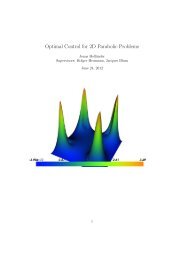
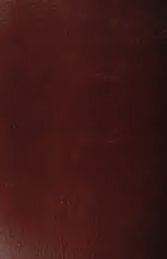
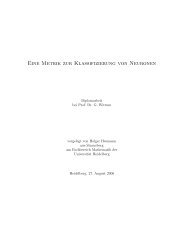
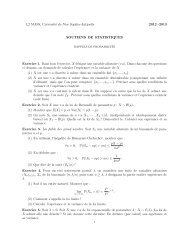
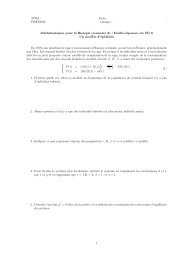

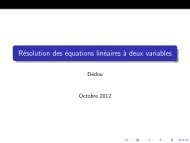
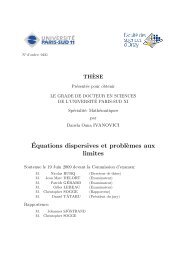
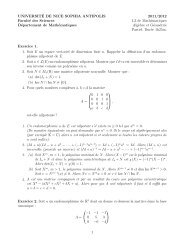
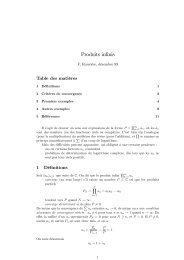
!['eries enti\`eres (+ [D78 Th d'Abel angulaire])](https://img.yumpu.com/14067031/1/184x260/eries-entieres-d78-th-dabel-angulaire.jpg?quality=85)
